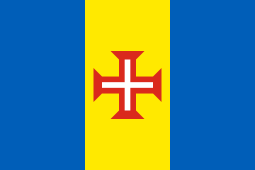Flag of Madeira
The flag of Autonomous Region of Madeira consists of a blue-gold-blue vertical triband with a Cross of Christ in the center.
 | |
| Use | Civil and state flag |
|---|---|
| Proportion | 2:3 |
| Adopted | 28 July 1978 |
| Design | A vertical triband of blue (hoist-side and fly-side) and gold with the cross of the Order of Christ centred on the gold band. |
The regulations and clarification of the dimensions, colours and symbolism of the flag of the Autonomous Region were approved by decree of the Legislative Assembly of Madeira of July 28, 1978 (Regional Decree n. º 30/78/M of 12 September)[1]. Its use has been made possible by the Portuguese Constitution, recognizing the status of the Madeira regional autonomy arrangements subject to the Constitution | Constitution itself, with Subjective right | right Insignia | badges that differentiate themselves from the rest of the Portuguese territory.
Design
History
The Madeiran flag design is heavily based on that of the flag of FLAMA, a right-wing terrorist paramilitary organisation from Madeira, whose main goal was to achieve Madeira's independence from mainland Portugal after the Carnation Revolution.
The FLAMA flag is composed of a blue-yellow-blue vertical triband, and in the yellow sections there are five small shields. The blue represents the environment that characterizes the island and represents nobility and serenity. The yellow mirrors the climate of the Archipelago, a symbol of richness, strength, faith and purity. The five shields, which are also present in the Portuguese flag stand for the five wounds of Christ (Portuguese: Cinco Chagas de Cristo) when crucified, and are typically associated with the legend in which Count Afonso Henriques (future Afonso I) "killed the five Moorish kings of the Seville, Badajoz, Elvas, Évora and Beja taifas. Hence, in gratitude to Jesus, he incorporated five shields arranged in a cross—representing his divine-led victory over the five enemy kings—with each one carrying Christ's five wounds in the form of silver bezants. The sum of all bezants (doubling the ones in the central shield) would give thirty, symbolizing Judas Iscarot's thirty pieces of silver".
Rational

According to the Legislative Assembly of Madeira's reasoning, published in the Regional Decree n. º 30/78/M of 12 September[2], which adopted the current flag, the similarity of designed was justified on the following grounds the Madeirans had "a vigorous reaction, demarcated in relation to everything that was objectively wicked [PREC]." Such reaction generated among the population a "mythical vagueness typical of such historical-community phenomena" which lead Madeirans to adopt the use of blue and gold colours as identifiers for the Region.
Members of the regional parliament further argued that "such colours gained such an implantation within the Madeiran population that, repudiating the immense majority of the anti-Portugueseism of the separatists, the significance was implanted as meaning something substantial about the Autonomous Region's own personality." Therefore, any other insignias with other colours would mean nothing to the Madeirans and the separatists would develop around the blue and gold an aura of heroic clandestinity, easy and superficial attractive to the collective subconscious, to the point that they could successfully impose anti-patriotic symbology."
By adopting the blue and gold, the Region's elected representatives met the essential collective motivation and destroyed the separatist mystification, removing any identifying mark and consecrated the colours as a symbol of autonomy within of the Portuguese Republic.
Symbolism
Colours
The blue represents the environment that characterizes insularity and represents nobility, beauty and serenity. The gold mirrors the mildness of the archipelago's climate and symbolizes wealth, strength, faith, purity and constancy.[1]
Cross of the Order of Christ
The Cross of the Order of Christ alludes to the following historical facts:
- The archipelago was discovered by two knights of the Household Henry the Navigator, who was Grand Master of the Military Order of Christ: João Gonçalves Zarco and Tristão Vaz Teixeira; becoming therefore a symbol of connection with Portugal;
- Since its discovery, was the archipelago was property of the Order of Christ, which promoted its settlement (only in the reign of D. Manuel the archipelago was called to the direct possession of the Portuguese Crown).
See also
References
- "Símbolos da Autonomia". ALRAM - Assembleia Legislativa da Região Autónoma da Madeira. Retrieved 2020-02-22.
- Regional, Região Autónoma Da Madeira-Assembleia. "Decreto Regional 30/78/M, de 12 de Setembro". Diários da República (in Portuguese). Retrieved 2020-02-22.
